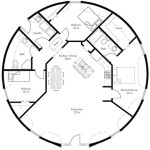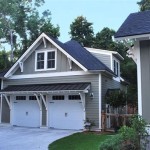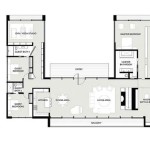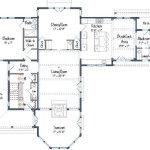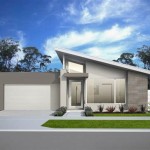Modern Floor Plans: The Appeal of One-Story Living
Single-story homes are experiencing a resurgence in popularity, driven by a desire for accessibility, simplified living, and a closer connection to the surrounding environment. Modern floor plans for one-story homes are designed with open concepts, abundant natural light, and a focus on seamless indoor-outdoor transitions. These designs cater to a wide range of demographics, from young families to empty nesters, offering flexibility and adaptability that aligns with diverse lifestyles.
Historically, single-story homes were prevalent due to ease of construction and the limitations of early building technology. However, with advancements in architecture and engineering, multi-story homes became more common, particularly in urban areas where land was at a premium. Despite this shift, the inherent advantages of one-story living have continued to resonate with many homeowners, and modern design principles are now maximizing the potential of single-level architecture.
The development of modern floor plans for one-story homes reflects a broader trend towards prioritizing functionality, aesthetics, and sustainability. Architects are incorporating innovative building materials, energy-efficient systems, and layouts that promote comfortable and convenient living. This article will explore the key aspects of modern one-story floor plans, emphasizing their advantages and design considerations.
Accessibility and Universal Design
One of the most significant advantages of one-story homes is their inherent accessibility. Eliminating stairs makes these homes ideal for individuals with mobility limitations, including elderly residents or those with disabilities. This feature aligns with the principles of universal design, which aims to create spaces that are usable by all people, to the greatest extent possible, without adaptation or specialized design. Modern one-story floor plans often incorporate wider doorways, roll-in showers, and strategically placed grab bars to enhance accessibility for residents of all ages and abilities.
Beyond addressing specific mobility needs, the absence of stairs reduces the risk of falls, promoting safety and peace of mind for families with young children. The ease of maneuvering throughout the home simplifies daily tasks such as carrying groceries, doing laundry, and cleaning. From a long-term perspective, one-story living allows homeowners to age in place comfortably and independently, without the need for costly renovations or relocation.
The focus on accessibility extends to the exterior of the home as well. Modern one-story floor plans often incorporate features such as zero-step entryways, gently sloped walkways, and accessible landscaping to create a seamless transition between indoor and outdoor spaces. These design elements not only enhance convenience but also contribute to the overall aesthetic appeal of the home.
Open Concept Living and Spatial Efficiency
Modern one-story floor plans typically embrace open concept living, which involves minimizing or eliminating walls between the main living areas, such as the kitchen, dining room, and living room. This design approach creates a sense of spaciousness and allows for improved flow of natural light throughout the home. Open concept layouts are particularly well-suited for single-story homes, as they maximize the use of limited square footage and create a more convivial atmosphere for entertaining and family gatherings.
Spatial efficiency is a key consideration in modern one-story floor plans. Architects carefully plan the layout to ensure that every square foot is utilized effectively. This often involves incorporating multi-functional spaces, such as a home office that can also serve as a guest room, or a kitchen island that provides both counter space and seating. Built-in storage solutions, such as custom cabinetry and integrated shelving, are also commonly used to maximize storage capacity and minimize clutter.
The emphasis on spatial efficiency extends to the design of individual rooms. Bedrooms are typically designed with ample closet space and strategically placed windows to optimize natural light and ventilation. Bathrooms often feature streamlined layouts with walk-in showers and minimalist fixtures to create a spa-like atmosphere. By carefully considering the function and flow of each space, architects can create a one-story home that feels both spacious and comfortable, despite its limited footprint.
Furthermore, the open floor plan can be easily adapted to the occupant's changing needs. As families grow or lifestyles evolve, the layout can be reconfigured with minimal effort to accommodate new furniture arrangements or the addition of new living spaces.
Indoor-Outdoor Connection and Natural Light
Modern one-story floor plans prioritize a strong connection between the indoor and outdoor environments. This is achieved through the use of large windows, sliding glass doors, and strategically placed outdoor living spaces, such as patios, decks, and courtyards. By blurring the boundaries between the interior and exterior, architects can create a sense of openness and tranquility, while also maximizing the benefits of natural light and ventilation.
Natural light is a key element in modern one-story design. Large windows and skylights are strategically placed to capture sunlight throughout the day, reducing the need for artificial lighting and creating a brighter and more inviting atmosphere. The use of light-colored walls and reflective surfaces further enhances the distribution of natural light throughout the home. This emphasis on natural light not only improves the aesthetics of the space but also contributes to the overall well-being of the occupants.
Outdoor living spaces are an integral part of modern one-story floor plans. Patios, decks, and courtyards are designed to extend the living space of the home, providing areas for relaxation, entertaining, and outdoor dining. These spaces are often seamlessly integrated with the interior through the use of sliding glass doors or French doors, creating a smooth transition between indoor and outdoor living. Landscaping is also carefully considered to create a visually appealing and functional outdoor environment.
The design should also consider the local climate when maximizing the indoor-outdoor connection. In warmer climates, features such as covered patios and outdoor kitchens can provide shade and create comfortable spaces for outdoor living throughout the year. In cooler climates, features such as sunrooms and enclosed porches can extend the usability of outdoor spaces during the shoulder seasons.
The integration of sustainable materials also enhances the design. Low-E glass windows and doors minimize heat transfer, reducing energy consumption and improving thermal comfort. The strategic placement of trees and shrubs can provide shade and reduce the need for air conditioning, while also enhancing the aesthetics of the landscape. These sustainable design features not only benefit the environment but also contribute to the long-term value and appeal of the home.
Moreover, carefully planned landscaping can provide privacy, create microclimates, and enhance the overall aesthetic appeal of the property, making outdoor spaces more enjoyable and functional for residents.
Energy Efficiency and Sustainability
Modern one-story floor plans often incorporate a variety of energy-efficient and sustainable design features to minimize environmental impact and reduce operating costs. These features may include energy-efficient windows and doors, high-performance insulation, solar panels, and rainwater harvesting systems. By prioritizing sustainability, homeowners can create a more comfortable and environmentally responsible living environment.
The orientation of the home is a crucial factor in maximizing energy efficiency. Architects carefully consider the position of the building relative to the sun to optimize passive solar heating and cooling. In colder climates, homes are often oriented to maximize southern exposure to capture solar heat during the winter months. In warmer climates, homes are oriented to minimize western exposure to reduce heat gain during the afternoon.
The choice of building materials also plays a significant role in energy efficiency and sustainability. Materials such as recycled content insulation, sustainably harvested wood, and low-VOC paints can reduce the environmental impact of the construction process and improve indoor air quality. The use of durable and long-lasting materials can also reduce the need for future repairs and replacements, further minimizing environmental impact.
Smart home technology can also be integrated into modern one-story floor plans to enhance energy efficiency and convenience. Smart thermostats, lighting controls, and appliance monitors can help homeowners track and manage energy consumption, reducing waste and lowering utility bills. Automated irrigation systems can also help conserve water by delivering the right amount of water to plants at the right time.
Water conservation is another important consideration in sustainable design. Low-flow toilets, showerheads, and faucets can significantly reduce water consumption without sacrificing performance. Rainwater harvesting systems can be used to collect rainwater for irrigation, reducing the demand for municipal water supplies. Xeriscaping, which involves using drought-tolerant plants and landscaping techniques, can further reduce water consumption and create a more sustainable landscape.
These combined efforts translate into long-term savings on utility bills, reduced environmental impact, and a more comfortable and healthy living environment for the homeowners. This also enhances the resale value of the property.

Small One Story 2 Bedroom Retirement House Plans Houseplans Blog Com

Modern Single Y House Plans Designs

Unique And Modern Single Story 2 500 Sq Ft House Plans Blog Homeplans Com

Our Favorite Unique One Story House Plans Blog Dreamhomesource Com

1 Story Contemporary Ranch House Plans With 2 Bedrooms

Meadowcove House Plan

Single Story Contemporary House Plan 69402am Architectural Designs Plans

One Story Modern Farmhouse Floor Plans

Attractive Modern One Story House Design Pinoy Eplans

Best One Story House Plans And Ranch Style Designs

